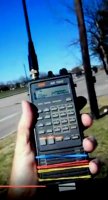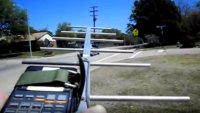Herein is a brief list of the equipment I use regularly to successfully DF (direction find or locate) power line noise (PLN) which shows up from time to time on the “low bands” (defined as 160 meters 1.8-2.0 MHz and 75/80 meters 3.5-4.0 MHz.)
It is particularly difficult to track down power line noise issues on the low bands on account of the lack of directional (beam) antennas employed at most amateur stations and on account of the size of antennas necessary to implement a 1/2 wave dipole let alone a 3-element Yagi beam (a 1/2 wave at 160 meters is ~256 feet) .
While units like the MFJ-856 “Line Noise Meter w/3 Element Beam” are useful for DFing close-in line noise sources, they (generally, 98 times out of 100) will not detect RFI sources a mile or more away which I have seen affect the 160/80 meter “low bands” to the exclusion of the other bands. Tracking down these +1 mile away noise sources on the low bands is the forte of the Marine DF unit.
 Portable Marine-band (1.6 – 4.0 MHz) DF receiver
Portable Marine-band (1.6 – 4.0 MHz) DF receiver
Purpose: Receive and DF noise on the 160 and 80/75 meter ham bands.
This particular piece of equipment can facilitate the taking of a unique compass bearing of an offending ‘noise’ source located at some distance. Using the Marine receiver’s rotatable loopstick antenna and Sense antenna functionality allows unambiguous bearings to be taken in the direction of power line noise emitters.
One such Marine-band band capable rx unit is the “Coastal Navigator” model number FR-662B. This unit may also be known as a “Maricom 1.” Here is a description of the FR-662B unit:
http://www.radiomuseum.org/r/unknown_all_transistor_direction.html
Note: When within the RF “near field” of an emitter (within 1/4 to 1/2 wave length, 128 to 256 ft on the 160 meter band) it may be difficult to establish a good ‘bearing’ on a noise source. Recall that 1/4 WL at 1.9 MHz is about 130 feet, and when this close to most power line noise sources the noise source *will* be heard on the VHF equipment described below in the next section.
The FR-662B units cover the following frequency ranges: 170 – 400 kHz, 550 – 1600 kHz and 1.6 – 4.0 MHz. These units receive AM only, but have the unique ability to modulate a plain carrier with about a 500 Hz tone; this unit does not incorporate a BFO as such and therefore is unsuitable for SSB reception.
Other marine DF units such as the Bendix Benmar 555A have been tried and these units do not seem to have Sense functionality even though they seem to be equipped with the capability, and I have tried three different Benmar 555A radios.
 VHF Hi-band AM-mode (not FM) receiver w/rubber duck antenna
VHF Hi-band AM-mode (not FM) receiver w/rubber duck antenna
Purpose: This equipment combo will get you to within a pole or two of the offending noise source after using the DF receiver above to get into the area of the noise source.
I use an old AOR “AR-1000” scanner in AM rx mode tuned to 147 MHz for this purpose.
 UHF AM-mode (not FM) receiver with a handheld Yagi ‘beam’ antenna
UHF AM-mode (not FM) receiver with a handheld Yagi ‘beam’ antenna
Purpose: Identification of a unique, individual offending pole can be accomplished using this equipment combination.
The old AOR “AR-1000” scanner in AM rx mode tuned to 450 MHz is used here too.
Here is a page with a review of early model marine DF and navigation receivers:
http://www.angelfire.com/space/proto57/rdf.html
